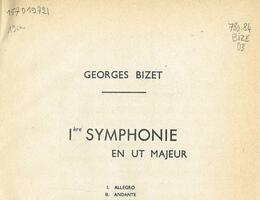Symphony in C
Allegro vivo – Adagio – Allegro vivace – Allegro vivace
Composed in 1855 when Bizet was just seventeen years old, this symphony was heard in public for the first time on 26 February 1935, in Basel, under the baton of Felix Weingartner. Bizet’s widow had given the manuscript to Reynaldo Hahn, who bequeathed it to the Paris Conservatoire. Its existence was first revealed in 1933 by the French musicologist Jean Chantavoine, but it was the composer’s first biographer, Douglas Charles Parker, who brought the score to Weingartner’s attention. Bizet’s extensive correspondence shows no mention of the work. Was it because from an early age he concentrated his efforts on operatic works, and other genres (especially when they were student assignments) appeared minor to him? Possibly. Or did he feel that it drew too much on Gounod’s Symphony in D (begun in 1843 and created by Jules Pasdeloup on 4 February 1855)? His work on a four-hand piano arrangement of the Symphony in D inspired him to go on to compose his own Symphony in C, which bears some similarities to its model, notably the fugal episode in the middle of the slow movement. Despite that influence, Bizet shows amazing mastery of timbre (we are reminded of Schubert who, with few exceptions, never heard the orchestration he had elaborated). The light touch, transparent textures and refreshing inspiration found in this work make up for a discourse that is sometimes a little meagre (the first movement, for instance, constantly follows the same rhythmic pattern). Let us note in particular the beautiful oriental-style solo for the oboe in the Adagio, the rustic tones of the Trio in the middle of the third movement, the melodic and rhythmic inventiveness that is in evidence in the finale.

